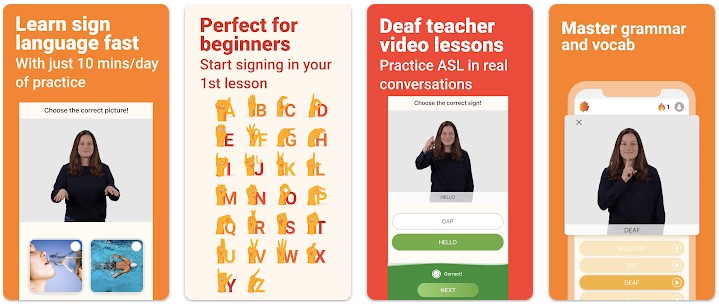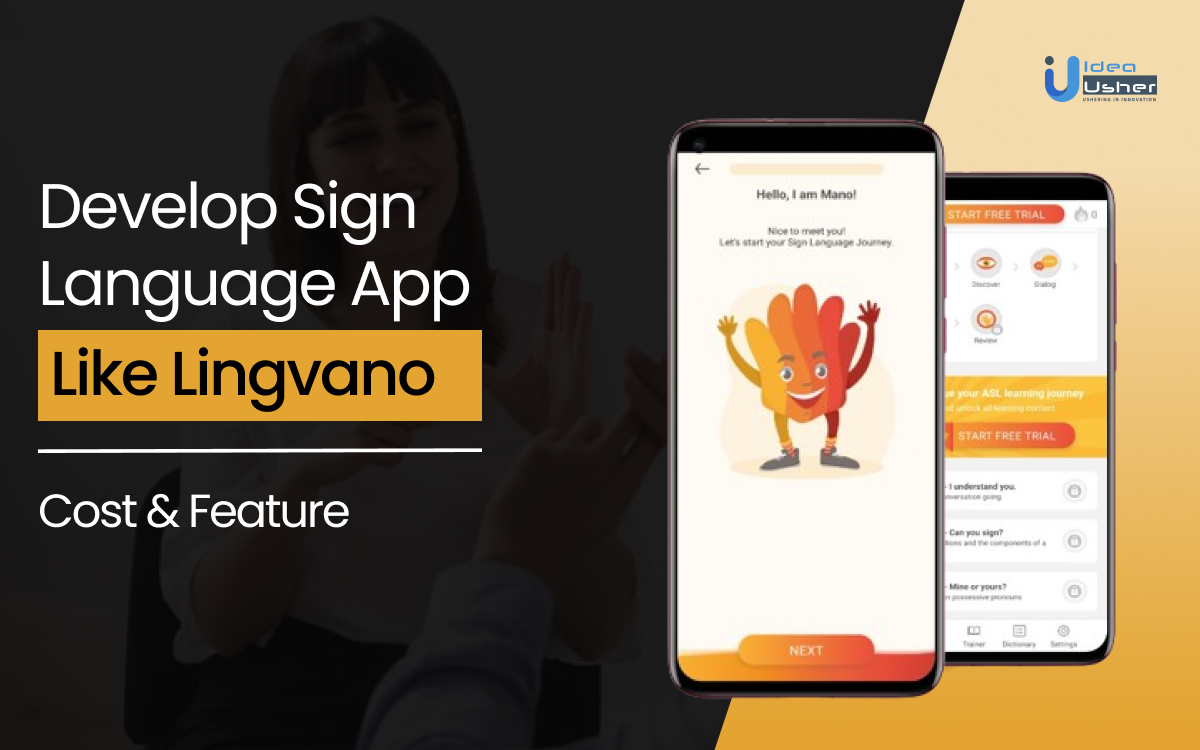Communication barriers are being broken down, and learning sign language is more relevant than ever, especially as we strive for greater communication inclusivity. Moreover, a report by WHO suggests that more than 5% of the world’s population is experiencing hearing loss, and this number will continue to rise in the future. These concerns are the reason that we need effective communication tools that can teach multiple languages and sign languages as well.
Luckily, we have several such apps that provide these conveniences, and among them, Lingvano is making a difference by offering an engaging and practical way to learn ASL. But there’s always room to create better solutions than the existing ones. Even the reports project that the eLearning app market will hit $400 billion by 2026, which underscores the opportunity to experiment in this space.
So, if you’re considering investing in this niche, now is an excellent time to get started. In this blog, we’ll explore how you can develop a sign language app like Lingvano, covering essential aspects like costs and features to help you get started.
Lingvano: Overview

Lingvano was founded in 2018. It is a platform dedicated to eliminating the communication gap between Deaf and hearing communities. Its goal is to help people connect through sign language, and thus, it makes it accessible to everyone through its platform.
Lingvano offers a comprehensive learning experience in American Sign Language and British Sign Language. The lessons in this app are created and taught by Deaf educators and cover a wide range of topics. They are designed to be short and practical to help users quickly apply what they learn in real-life situations.
To make learning more engaging, this app also includes several interactive tools. Users can practice conversation skills, expand their vocabulary, and refine their signing with the help of a sign mirror. This tool allows users to compare their own signs with those demonstrated by instructors so they can improve their technique.
Lingvano is a valuable resource for anyone looking to improve their communication with the Deaf community, whether for personal, educational, or professional reasons.
What Makes The Lingvano App Unique?
Lingvano offers a variety of features designed to enhance the Sign Language learning experience. These features include:
- Interactive Lessons: Immerses users in real-life scenarios for practical application of skills.
- Vocabulary Trainer: Utilizes advanced algorithms to enhance memory retention and recall of signs.
- ASL Dictionary: Comprehensive tool for quick searches of specific signs or phrases, enriching the learning experience.
- Sign Mirror: Offers real-time feedback by allowing users to compare their signing with expert demonstrations, aiding in confidence-building and technique improvement.
- Conversation Skills Modules: Focuses on real-world dialogues to prepare users for everyday interactions in Sign Language.
Lingvano’s key features by the panel:
| Panel | Features |
| Home Panel | Overview of user’s progress, Daily learning goals and streaks |
| Lessons Panel | Interactive video lessons by Deaf teachers, Practical conversation skills |
| Vocabulary Trainer Panel | Reinforcement of memory, Practice and review vocabulary |
| Dictionary Panel | Lookup specific signs or sentences, Comprehensive sign reference |
| Sign Mirror Panel | Practice signing, Gain confidence in signing skills |
| Profile Panel | Progress tracking, Manage account settings and preferences |
How Does Lingvano App Work?
Here is how the Lingvano app work:
- The app offers short and engaging lessons created by Deaf instructors. Users begin learning sign language immediately through these lessons.
- They can practice with real-life dialogues in the app to quickly develop their ASL conversational skills.
- There is a Vocabulary Trainer and an ASL Dictionary in the app. The Vocabulary Trainer helps users practice and retain new signs, and the ASL Dictionary helps users understand specific signs and sentences.
- Users can also use the Sign Mirror feature of the app to practice signing and comparing their performance with the app’s examples to improve their skills.
- The app enables users to sync their progress across devices like smartphones, tablets, and laptops. It requires just 10 minutes of practice in a day to see progress.
Key Market Takeaways For Sign Language Apps
The sign language app market is projected to grow at a compound annual growth rate of 7.3% from 2023 to 2028.
Factors responsible for growth:
- Increased recognition of the benefits of sign language apps, such as improved performance and efficiency.
- Increased adoption of smart devices.
- Rising demand for online educational tools.
- Sign language apps offer a flexible and engaging way to support learning.
- Schools’ emphasis on teaching sign language benefits both deaf and hearing students.
- Growing deaf population.
Hearing loss statistics:
- The World Health Organization estimated that at least 700 million people will need hearing rehabilitation by 2050.
- About 2.5 billion people globally are expected to experience some level of hearing loss by 2050.
- More than 1 billion young adults face the risk of permanent, preventable hearing loss due to unsafe listening habits.
Business Model Of Lingvano
Lingvano employs a subscription-based model to sustain and improve its sign language learning platform. This approach eliminates the need for ads and third-party funding, which allows for a more focused and uninterrupted user experience.
Pricing Structure Of Lingvano
There are two plans, Free and Premium. Free Plan offers a limited selection of lessons and features at no cost, providing users a glimpse into the platform’s offerings. On the other hand, the Premium plan gives access to the premium features, such as:
- Access to All Lessons: Subscribers can explore the complete range of lessons.
- Additional Learning Tools: Includes a dictionary, Vocab Trainer, and Sign Mirror, enhancing the learning experience.
- Ad-Free Experience: Ensures an uninterrupted, focused learning environment.
The premium plan is available in three tiers:
| Subscription Plan | Cost | Equivalent Monthly Cost | Benefits |
| Monthly Subscription | $17.99 per month | $17.99 per month | Flexibility with short-term commitment |
| Quarterly Subscription | $47.97 every three months | $15.99 per month | Discounted rate for a three-month commitment |
| Annual Subscription | $119.88 per year | $9.99 per month | Most economical option with significant savings |
Features That Make Lingvano Popular Among Its Users
Lingvano’s appeal lies in its unique features, which are designed to offer an engaging and comprehensive learning experience.
1. Focused Sign Language Instruction
Lingvano specializes in teaching American, British, and Austrian Sign Language, i.e., ASL, BSL, and OEGS. This concentrated focus makes sure that learners receive high-quality and personalized instruction in each sign language and that they can enhance their learning experience.
2. Engaging Interactive Lessons
The platform provides video lessons presented by Deaf teachers. This format makes the learning process more engaging and authentic. It allows users to start practicing sign language from their first lesson. The interactive nature of the lessons helps learners retain information and improve signing skills.
3. Literal English Translations
Lingvano offers literal English translations for ASL phrases. This feature helps users grasp the grammar and structure of the language and makes it easier to learn and use sign language effectively in the real-world.
4. Flexible Learning Options
Lingvano’s platform is accessible on smartphones, tablets, and laptops. Learner’s progress is synchronized across devices, which allows them to learn anytime and anywhere. This flexibility makes sure that users can fit their studies into their schedules without being tied to a single device.
5. Adjustable Video Playback Speed
For users who find the signing speed too fast, Lingvano provides an option to slow down the video playback. This adjustment helps learners understand and practice signs more accurately.
6. Comprehensive Course Structure
The ASL course is organized into 102 lessons divided into 8 sections, which cover everything from basic vocabulary to complex conversations. This well-structured approach ensures a thorough understanding of the language and progression from beginner to advanced levels.
7. Additional Learning Tools
Premium users benefit from extra resources such as a dictionary, Vocab Trainer, and Sign Mirror. These tools enhance the learning experience by offering additional practice and review options and help users build and reinforce their vocabulary.
8. Ad-Free And Privacy-Focused
One of the most loved features of Lingvano is that it provides a completely ad-free environment and is committed to user privacy. The platform does not sell user data, and it creates a distraction-free and secure space for learning.
Innovative Features That Can Enhance An App Like Lingvano
Here are some features that you can incorporate to significantly improve an app like Lingvano:
1. Advanced Gesture Recognition
Integrate gesture recognition technology to provide real-time feedback on users’ signing accuracy. This feature analyzes hand movements and offers corrections. It can help users refine their skills and improve their precision of signing.
2. Immersive VR Environments
Create VR settings where users can practice sign language in realistic scenarios, such as dining out or asking for directions. This approach offers a practical way to use sign language in everyday situations.
3. Interactive Storytelling
Develop interactive story modes that allow users to navigate through scenarios using sign language. This feature can allow users to practice conversation skills in a fun and engaging way, which can improve their ability to use sign language in various contexts.
4. Custom Sign Language Keyboard
Introduce a sign language keyboard for messaging apps. This feature allows users to communicate in sign language through text. Integration of such features into daily communication can make it easier to learn and understand sign language easily.
5. Real-Time Sign Language Translation
Add a real-time translator that converts spoken or written language into sign language. This tool can help users understand and communicate more effectively and can eliminate the gap between different languages.
6. AI-Powered Personal Tutor
Develop an AI tutor that offers personalized lessons based on user progress. This feature will enable the tracking of learning patterns, the adaptation of lessons to individual needs, and the provision of personalized feedback.
7. Daily Sign Language Challenges
Introduce daily or weekly challenges that encourage users to practice sign language regularly. Rewards for completing these challenges can motivate users to stay engaged and continuously improve their skills.
Development Steps For Sign Language Apps Like Lingvano
Developing an effective sign language app like Lingvano involves several key development steps:
1. Analyze Sign Language Linguistics
Begin by examining the complexities of sign languages. Incorporate regional dialects and variations to ensure the app is suitable for a global audience. Understand the historical development of sign languages to add depth and context. This foundational step helps in creating a comprehensive and culturally relevant learning tool.
2. Develop Advanced Recognition Technology
Focus on creating advanced algorithms for recognizing facial expressions, which are important for interpreting sign language accurately. Implement high-precision technology to detect handshapes and movements. Ensure that the system performs well under different lighting conditions. This step is important for providing users with reliable feedback on their signing practice.
3. Design Personalized Learning Paths
Implement a system that adjusts the difficulty of lessons based on individual user performance. Create functionality for users to build custom vocabulary lists aligned with their interests and learning objectives. This personalization ensures that the app meets each user’s specific needs and helps maintain engagement throughout their learning journey.
4. Integrate Accessibility Features
Develop accessibility features such as closed captioning in multiple languages to support users with hearing impairments, including those who are deaf-blind. Incorporate Augmented Reality to provide 3D visualizations of sign language movements. This step improves the app’s usability for users with different learning preferences and needs.
5. Build Social And Collaborative Tools
Create real-time video communication capabilities to allow users to practice sign language with native speakers or fellow learners. Include features that enable users to contribute their own content, such as sign language videos and quizzes. This initiative can build a collaborative learning environment and provide practical experience to your users, which can result in user retention.
6. Offline Capability And Data Privacy
Develop an offline mode to allow users to access and practice content without an internet connection. Implement security measures to protect user data, including personal information and video recordings. This step is obviously important for maintaining user privacy and ensuring the app’s functionality in areas with limited connectivity.
7. Promote Cultural Sensitivity And Inclusivity
Incorporate sign language models from various cultural backgrounds to ensure diverse representation. Provide explanations of cultural and historical context to enhance users’ understanding of the language. This approach supports a respectful and inclusive learning environment, which contributes to a more engaging user experience.
Tech Stack For Lingvano Clone App Development
Here’s the tech stack required for the development of Lingvano clone app development:
| Category | Technology | Purpose |
| Frontend Development | React Native | Cross-platform mobile app development |
| Redux | State management | Efficient state handling |
| Backend Development | Node.js | Server-side scripting |
| Express.js | Web application framework | Simplifies API and web app development |
| Database | MongoDB | NoSQL database |
| PostgreSQL | Relational database | Strong ACID compliance |
| Cloud Services | AWS | Cloud infrastructure |
| Firebase | Backend-as-a-Service (BaaS) | Real-time database, authentication, analytics |
| AI and Machine Learning | TensorFlow | Machine learning framework |
| OpenCV | Computer vision library | Image and video processing |
| DevOps | Docker | Containerization |
| Kubernetes | Container orchestration | High availability and scalability |
| Additional Tools | GraphQL | API query language |
| Jest | Testing framework | Ensures code quality |
| Unique Features | Gesture Recognition | TensorFlow, OpenCV |
| AR/VR Integration | ARKit (iOS), ARCore (Android), Unity | Immersive learning experiences |
| AI-Powered Tutor | TensorFlow, NLP | Personalized learning paths, real-time feedback |
Some Revenue Generating Methods For Sign Language Apps
Here are some revenue-generating methods that are particularly relevant to sign language apps in 2024:
1. AI-Powered Certification
Implementing AI-driven assessments allows for precise measurement of users’ sign language skills. Offering certification programs can help users validate their proficiency, which is particularly appealing to job seekers and students. Additionally, forming partnerships with educational institutions can integrate these certifications into academic curricula, further enhancing their value.
2. Corporate Training Programs
Developing customized sign language training programs for corporations to address the need for improved communication with deaf and hard-of-hearing employees. Moreover, you can offer consulting services that can assist companies in enhancing their overall accessibility. You can also create tools like real-time captioning, which can be an additional revenue source for you.
3. Gamified Learning
Incorporating games and challenges into the app can make learning sign language both enjoyable and engaging. Introducing multiplayer features and rewards helps to keep users motivated and committed. Furthermore, revenue can be generated through in-app purchases or subscription plans, which adds another layer of monetization.
4. Assistive Technology Integration
Make sure the app works well with devices like hearing aids and screen readers. Offer settings that cater to various disabilities. Partner with companies that make assistive technology to expand your user base.
5. Interpreter Marketplace
Set up a platform within the app where users can find and book sign language interpreters. Charge a fee for each booking. Provide quality checks to maintain high standards and build trust among users.
6. Corporate Licensing
Sell licenses to businesses and educational institutions for bulk access to the app. Offer discounts for large purchases and provide custom versions for specific needs. This can create a steady revenue stream from organizations for you.
7. Live Classes And Coaching
Offer live online classes and personal coaching sessions for users who want more interaction. Provide group classes for those interested in learning with others. You can absolutely charge for these services through subscriptions or one-time payments.
Cost Of Developing A Sign Language App Like Lingvano
Here’s a breakdown of the cost to develop a sign language app like Lingvano, with approximate cost ranges for each component:
| Component | Description | Minimum Cost | Maximum Cost |
| Market Research | Conducting market research to understand user needs and market trends | $300 | $2,000 |
| UI/UX Design | Designing the user interface and user experience | $400 | $5,000 |
| Frontend Development | Developing the app’s frontend using React Native | $1,000 | $10,000 |
| Backend Development | Setting up the server, database, and APIs using Node.js and Express.js | $800 | $10,000 |
| Database | Implementing databases like MongoDB and PostgreSQL | $500 | $2,000 |
| App Features | Developing core features like interactive lessons, vocabulary trainer, etc. | $1,000 | $20,000 |
| Gesture Recognition | Implementing advanced gesture recognition technology | $700 | $10,000 |
| AI-Powered Tutor | Developing AI-powered personalized tutor features | $1,500 | $12,000 |
| AR/VR Integration | Adding AR/VR immersive learning experiences | $2,500 | $18,000 |
| Testing and QA | Conducting thorough testing and quality assurance | $300 | $3,000 |
| Deployment | Deploying the app to app stores and setting up cloud services | $500 | $3,000 |
| Maintenance and Updates | Ongoing maintenance and updates post-launch | $500 | $5,000 |
| Total Cost Range | – | $10,000 | $100,000 |
Cost-Affecting Factors To Consider For Sign Language App Development
Several factors can influence the overall cost of sign language app development. Understanding these variables can help in better budgeting and project planning:
- The complexity of the gesture recognition system is a major cost driver. Advanced algorithms that provide higher accuracy require more development time and resources, which leads to increased expenses.
- Creating high-quality video lessons with Deaf instructors can be costly. The total number of lessons, production quality, and instructor compensation all contribute to the overall cost. Additionally, interactive story modes that offer branching narratives and multiple outcomes add to the complexity and cost.
- Incorporating AI for personalized learning paths demands significant investment in machine learning models and data processing. AI-powered real-time feedback systems for sign language accuracy also require substantial resources.
- Developing AR/VR environments for immersive learning experiences involves specialized skills and tools, which increases development costs. Plus, ensuring compatibility with various AR/VR hardware further adds to the complexity and expense.
- Supporting multiple sign languages, such as ASL, BSL, or OEGS, involves additional content creation and localization efforts, which increase costs. Additionally, including lessons that offer cultural context for different regions also adds to content creation expenses.
Conclusion
Building a sign language app like Lingvano is a powerful way to make communication easier and more inclusive. This kind of app can help eliminate gaps between people and make learning sign language fun and effective. As technology continues to advance, creating tools that support everyone, including those with hearing impairments, is essential. It shows that you care about inclusivity and innovation. In fact, by backing solutions like this, you can boost your brand’s reputation and connect with more people. So, in this case, a well-designed sign language app can make a big difference and help you stand out as a leader in making a real impact.
Looking To Develop Sign Language Apps?
We bring over 10 years of experience and more than 50,000 hours of coding expertise to the table. Our track record includes delivering over 200 projects and showcasing our commitment to excellence. We have successfully developed several eLearning and educational apps like EduRev, AcceleratedX, etc., which demonstrates our ability to create inclusive and innovative solutions. So, partner with us to utilize our extensive experience and proven success in this field. With your concept and our labor, you can build an app to support the Deaf and hard-of-hearing community. Let’s make a difference with technology today!
Work with Ex-MAANG developers to build next-gen apps schedule your consultation now
FAQ
How to develop an app like Lingvano?
To develop an app like Lingvano, first, identify what users need and want. Design a user-friendly interface with features such as video lessons and interactive exercises. Build the app using appropriate programming tools, then thoroughly test it and gather user feedback before releasing it.
What is the difference between ASL Bloom and Lingvano?
Lingvano and ASL Bloom both teach ASL but use different methods. Lingvano focuses on videos and interactive exercises, making learning fun and engaging. It also includes features for practicing with others. ASL Bloom offers a more traditional approach with a set series of lessons and practice drills.
How many signs does Lingvano teach?
Lingvano teaches more than 1,000 ASL signs. This extensive range covers many basic and advanced signs, helping users learn and use ASL effectively in everyday situations.
What is the cost of developing an app like Lingvano?
Creating an app like Lingvano typically costs between $50,000 and $150,000. This range includes the costs of design, development, testing, and launching the app. Additional costs for marketing and ongoing maintenance may also apply.






















